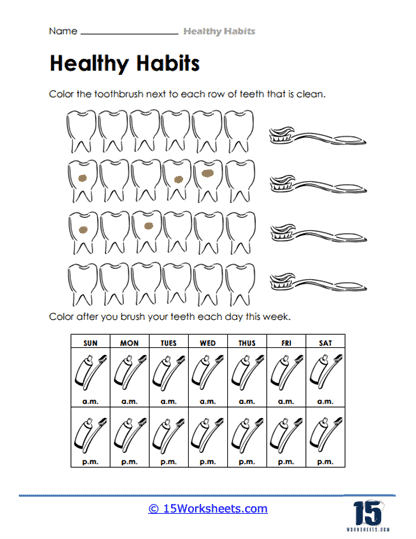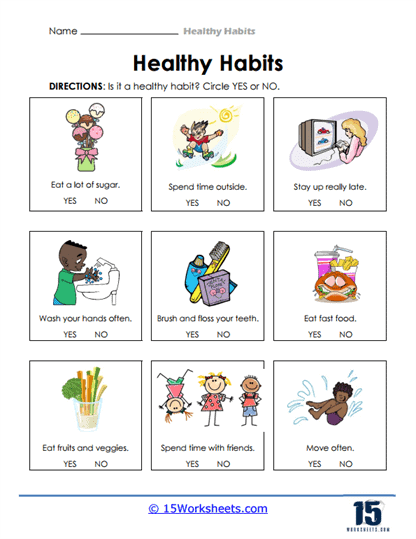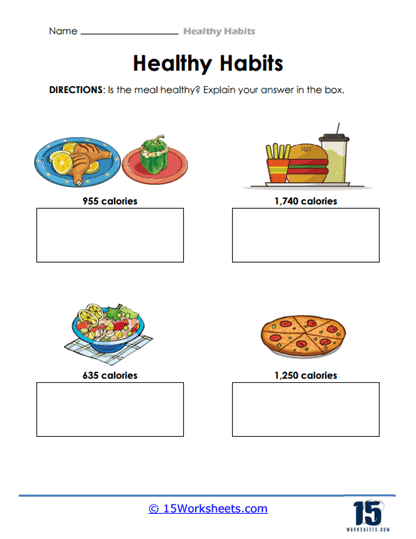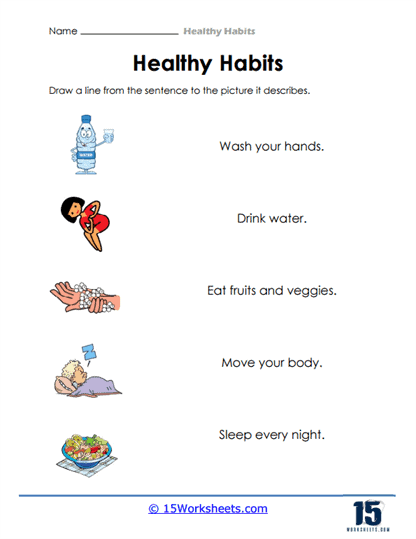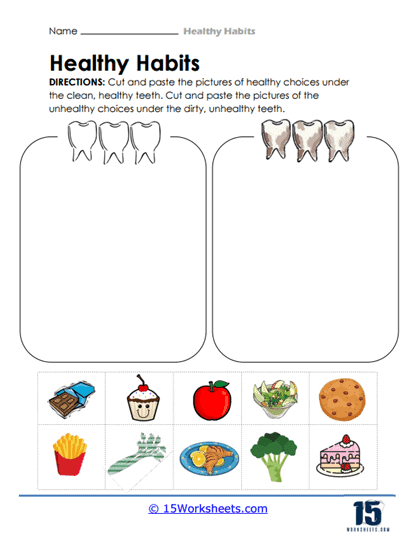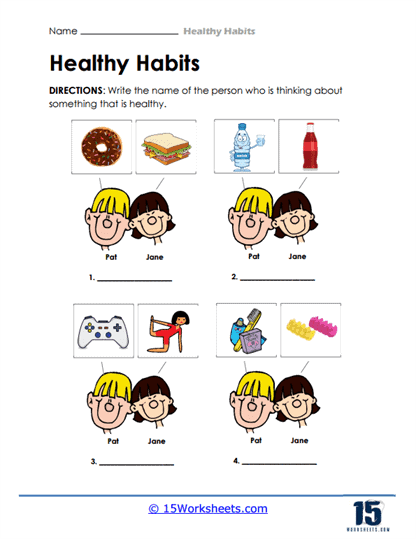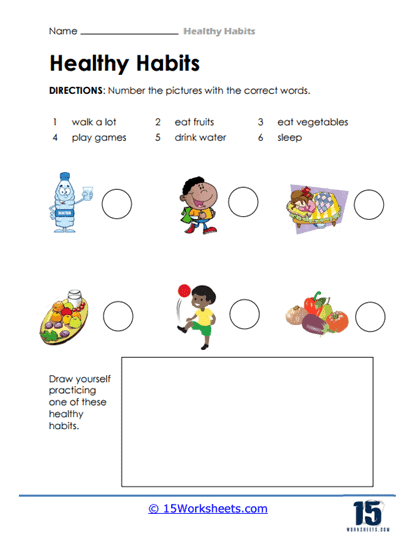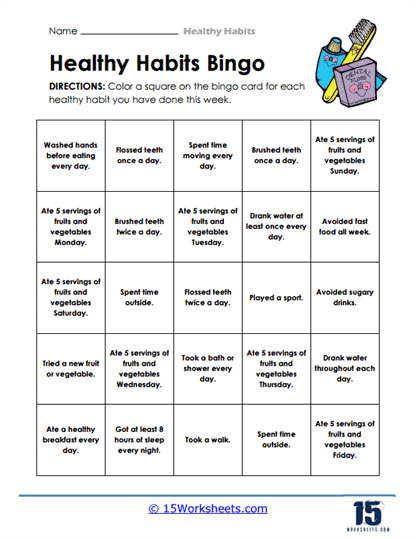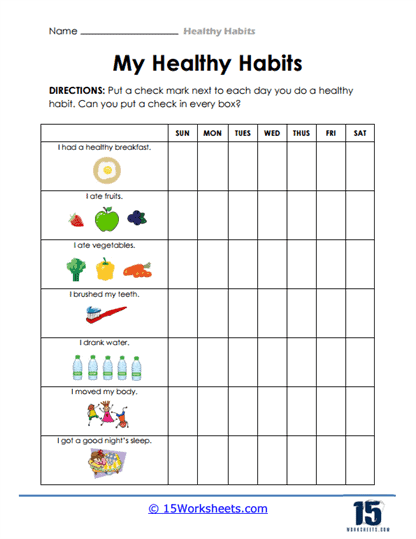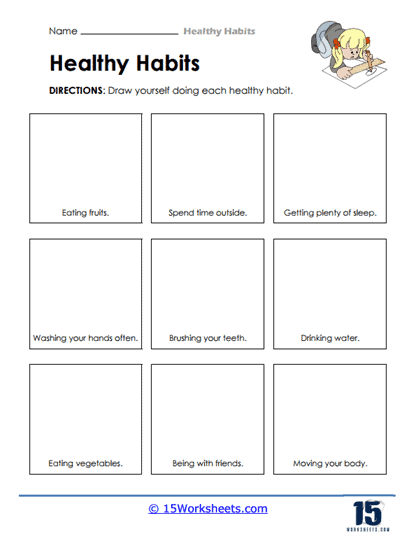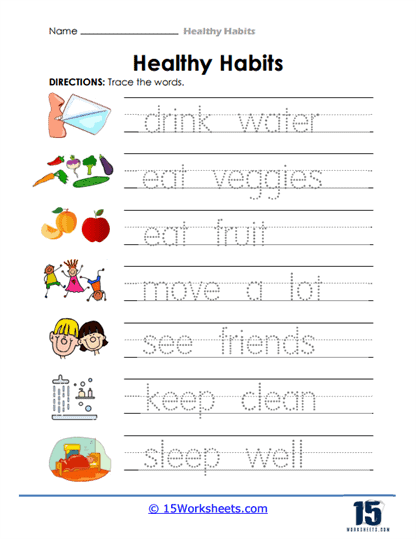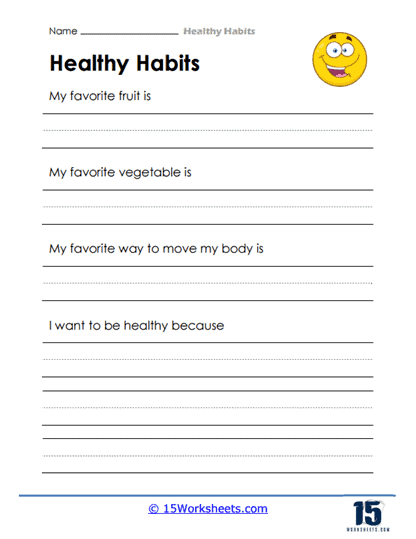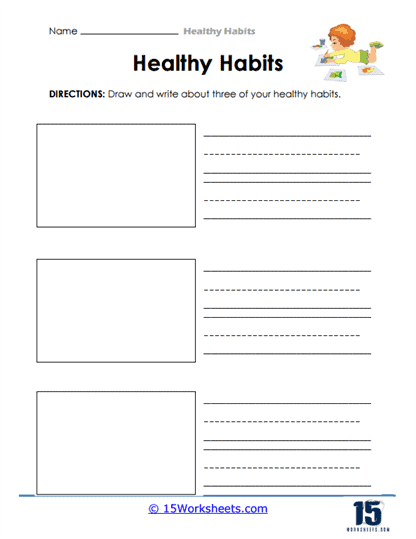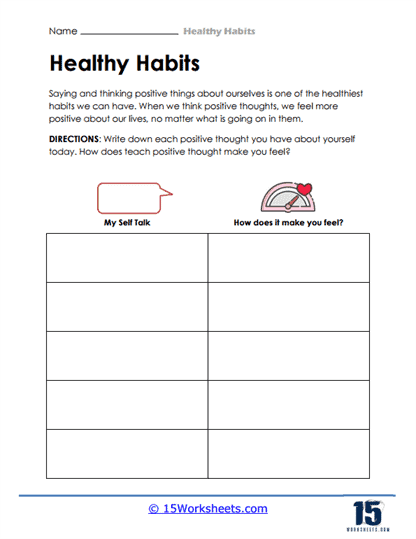Healthy Habits Worksheets
All About These 15 Worksheets
These worksheets teach students essential skills and behaviors that promote physical, emotional, and mental well-being. These worksheets are popular resources among teachers, homeschoolers, and tutors because they provide a structured way for students to learn about health-related topics. The purpose of these worksheets is to cultivate lifelong healthy habits in children, making them aware of how their daily choices impact their overall health. Each worksheet may focus on different aspects of health, such as nutrition, hygiene, physical activity, sleep, and emotional well-being, offering practical exercises that engage students and encourage them to think critically about their habits.
For students, these worksheets serve as a hands-on, engaging method to learn about the importance of maintaining a balanced lifestyle. They often contain fun activities that make learning about health exciting. Students might be asked to fill in charts, complete puzzles, or track their behaviors in relation to their health goals. These interactive exercises are designed to reinforce what they learn about nutrition, physical fitness, and mental health, making the lessons more personal and relatable.
For teachers in traditional classrooms, Healthy Habits worksheets are valuable because they align with various educational standards and help teach health education in a structured, age-appropriate way. Teachers can use them as supplements to classroom lessons on topics like the food pyramid, the importance of regular exercise, and maintaining hygiene. These worksheets also provide teachers with a convenient way to assess students’ understanding of the material, as they often include multiple-choice questions, reflection prompts, or journaling activities that students can complete on their own.
When it comes to the types of exercises you would expect to find in Healthy Habits worksheets, they typically cover a range of interactive and reflective activities.
Food and Nutrition Trackers
Food and nutrition trackers are powerful tools for encouraging students to be mindful of what they eat. In these worksheets, students typically log their meals over a week or more and categorize the foods they consume into groups such as proteins, carbohydrates, fruits, and vegetables. This kind of tracking promotes an awareness of nutrition and helps students identify patterns in their diet-such as whether they’re eating enough vegetables or consuming too many sugary foods. Through this process, students gain a deeper understanding of balanced nutrition, including the importance of variety and moderation. Additionally, evaluating their choices teaches them about portion control and the significance of maintaining a diverse diet. For younger students, these trackers often include illustrations of different foods, making the exercise more engaging and helping them associate food items with the proper food groups.
Physical Activity Logs
Physical activity logs allow students to track how much exercise they get and the types of physical activities they engage in, from sports to simple outdoor play. By logging activities like running, playing sports, or walking, students become more aware of the importance of staying physically active and how different activities contribute to their fitness. These logs often include spaces for students to reflect on how they felt after exercising, helping them see the connection between movement and well-being. For instance, a student might note that they felt more energized or happier after spending time playing outside. This also teaches them the importance of daily physical activity, reinforcing the idea that being active isn’t just about exercising for fitness—it’s also about maintaining mental and emotional health. By seeing their own patterns and tracking progress, students can be encouraged to incorporate more movement into their routines, which builds long-term healthy habits.
Sleep Diaries
A sleep diary encourages students to track their sleeping habits over a certain period, such as a week. They might record how many hours they sleep, what time they go to bed and wake up, and how rested they feel in the morning. These diaries help students reflect on whether they’re getting adequate rest and make connections between their energy levels and the quality of their sleep. By analyzing their patterns, students learn about sleep hygiene, such as the importance of consistent sleep schedules and reducing screen time before bed. The exercise highlights that sleep is a vital component of overall health, contributing to physical recovery, mental clarity, and emotional regulation. Over time, these diaries can help students recognize the value of good sleep habits and motivate them to make necessary adjustments for better rest.
Mindfulness and Stress Management
Mindfulness and stress management worksheets focus on emotional and mental well-being, offering exercises like deep breathing, meditation, or journaling. These activities help students develop self-regulation techniques for managing stress and anxiety. For example, students may be asked to list things that make them feel stressed and then practice simple mindfulness techniques like deep breathing to cope with those feelings. By introducing these concepts at a young age, these worksheets empower students to take control of their emotional responses and practice mindfulness, helping them build resilience. Over time, students become more self-aware and better equipped to handle daily stressors, which is a crucial skill not only for their school years but for life beyond the classroom.
Personal Goal Setting
Personal goal-setting worksheets encourage students to reflect on areas of their health where they would like to improve and create action plans. For instance, a student may set a goal to drink more water daily or to exercise for 30 minutes each day. By setting specific, measurable goals, students learn how to break down larger objectives into achievable steps, making long-term habits more attainable. These worksheets typically include progress tracking, allowing students to see how far they’ve come, which can be motivating. Goal-setting exercises also foster a sense of responsibility and self-efficacy, as students take ownership of their personal health journey. Over time, achieving these small goals builds confidence and reinforces the importance of persistence and self-care.
Hygiene Practices
Worksheets focused on hygiene practices teach students the importance of keeping their bodies clean to prevent illness and promote overall health. Activities might include visual guides showing proper handwashing techniques, brushing teeth, or taking care of skin. Students may be tasked with completing checklists, coloring pictures, or sequencing the steps involved in proper hygiene routines. For instance, a handwashing worksheet may ask students to color in the sequence of washing hands or to check off when they wash their hands before meals. By engaging with these activities, students learn why these practices are essential and how they can protect themselves and others from germs. Understanding the significance of hygiene helps students internalize these behaviors and incorporate them into their daily routines.
Reflection and Self-Assessment
Reflection and self-assessment exercises encourage students to think critically about their current habits. These worksheets might include prompts that ask students to evaluate how often they engage in healthy behaviors—such as exercising, eating well, or getting enough sleep—and then reflect on areas where they could improve. This process deepens students’ awareness of their own health practices and encourages them to take responsibility for their well-being. For example, a student might realize through self-reflection that they are not eating enough fruits and vegetables or getting enough exercise, which can lead to intentional changes. These exercises are vital for helping students develop self-awareness, and they foster a growth mindset by showing students that healthy habits are something they can build and improve over time.
Daily Hygiene Tracking
This specific exercise involves students coloring toothbrushes next to rows of teeth, identifying which ones are clean and which are dirty. The visual representation helps students associate brushing their teeth with keeping their mouths healthy. At the bottom, students can track whether they brushed their teeth in the morning and evening throughout the week. This type of tracking reinforces regular dental hygiene and helps children establish routines. By physically marking each day they brush, students become more consistent in their practices and develop a greater sense of accountability for their oral health.
Healthy vs. Unhealthy Habits
This worksheet features images depicting various habits, such as eating vegetables versus eating sugary snacks, and students must decide whether each habit is healthy or unhealthy by circling “Yes” or “No.” This simple, yet effective, exercise helps students distinguish between behaviors that contribute to well-being and those that do not. It fosters critical thinking by encouraging students to evaluate their own habits and understand why certain activities (like spending time outdoors) are better for them than others (like staying up late). Over time, this understanding translates into better choices, as students learn to prioritize healthy actions in their own lives.
Matching Sentences to Healthy Actions
This type of exercise asks students to match sentences like “Drink water” or “Move your body” with corresponding images. It reinforces the connection between everyday actions and their health benefits. By visually linking the action to its outcome, such as drinking water for hydration or sleeping for rest, students internalize the importance of these activities. This matching exercise also simplifies health concepts for younger children, making them easier to understand and apply in daily life.
Healthy Habits Bingo
In Healthy Habits Bingo, students are rewarded for completing healthy tasks, such as brushing their teeth or eating vegetables, by coloring in squares on a Bingo card. This gamified approach adds an element of fun to developing healthy habits. Because it tracks multiple behaviors, it encourages students to adopt a variety of good practices, not just focus on one area of health. By filling out the Bingo card over time, students see their progress in real-time, which can motivate them to continue making healthy choices. The non-competitive nature of the activity ensures that students are engaged and focused on self-improvement rather than comparison with others.
Cut and Paste Sorting – Healthy vs. Not Healthy
In this activity, students cut out various behaviors, such as “drink soda” or “drink water,” and paste them into the appropriate columns – “Healthy” or “Not Healthy.” This tactile exercise engages students’ motor skills while reinforcing positive and negative behaviors. The act of physically sorting the behaviors helps solidify students’ understanding of which actions contribute to good health. It also encourages them to actively engage with the material rather than passively absorb information, which can lead to better retention and understanding.
Food and Teeth Connection
This interactive cut-and-paste activity focuses on dental health, asking students to place pictures of healthy foods under clean teeth and unhealthy foods under dirty teeth. It visually demonstrates the impact of diet on oral hygiene, helping students understand that sugary or processed foods can cause cavities and tooth decay, while nutritious foods contribute to dental health. By making these connections in a hands-on way, students learn to associate healthy eating with clean, strong teeth and poor eating habits with negative outcomes.
What Are Important Healthy Habits For Kids?
Healthy habits are the routines and practices that contribute to a person’s overall well-being. For children, developing healthy habits early on is crucial for supporting their growth, physical health, emotional balance, and cognitive development. These habits help to build a foundation for lifelong wellness, teaching kids how to care for their bodies, manage their emotions, and form positive routines. Encouraging children to develop healthy habits not only benefits their immediate health but also instills a sense of responsibility and self-awareness as they grow.
Eating a Balanced Diet – One of the most important healthy habits for kids is maintaining a balanced diet. Proper nutrition fuels the body, supports growth, and boosts immune function. A balanced diet includes a variety of fruits, vegetables, whole grains, lean proteins, and healthy fats. By learning to make nutritious choices from an early age, kids can develop a positive relationship with food, avoid unhealthy eating patterns, and reduce the risk of childhood obesity and related health issues. Additionally, good nutrition helps with brain development and focus, giving kids the mental clarity and stamina they need for learning and problem-solving at school. Encouraging balanced meals also sets the stage for lifelong healthy eating habits.
Engaging in Regular Physical Activity – Daily physical activity is essential for a child’s physical health, helping to strengthen muscles, improve coordination, and maintain a healthy weight. It also enhances mental well-being by reducing stress and anxiety, boosting mood, and improving focus and concentration. Activities like running, playing sports, biking, or even playing at the park can keep kids active and help them develop a love for movement and exercise that will carry into adulthood. Regular exercise also improves heart health and builds strong bones, which is particularly important during the growing years. Moreover, physical activity helps children build social skills and teamwork when they engage in group sports or cooperative play.
Getting Enough Sleep – Adequate sleep is vital for children’s physical and cognitive development. During sleep, the body heals, grows, and processes the events of the day, while the brain solidifies learning and memory. Most school-aged children need between 9 to 11 hours of sleep per night. Establishing a consistent bedtime routine helps kids get the rest they need, improving their energy levels, mood, and ability to focus throughout the day. A lack of proper sleep can lead to irritability, difficulty concentrating, and even long-term developmental problems, so it’s crucial for both their short-term behavior and long-term health. Healthy sleep patterns also foster emotional regulation, helping children manage their emotions better in social and academic settings.
Practicing Good Hygiene – Teaching children proper hygiene habits is important for preventing illness and promoting overall health. Regular hand washing, brushing teeth twice a day, bathing, and wearing clean clothes are simple practices that contribute to their well-being. These habits not only help keep them healthy but also build their confidence and social interactions, as kids who feel clean and well-groomed tend to feel more comfortable around others. Good hygiene also sets the foundation for self-discipline, as children learn to care for their bodies regularly. This awareness of personal hygiene can prevent the spread of infections and illnesses, keeping both the child and their peers healthier in school and at home.
Staying Hydrated – Drinking enough water is often overlooked but is critical to maintaining good health. Hydration supports all bodily functions, from digestion to temperature regulation and cognitive performance. Children should be encouraged to drink water throughout the day rather than sugary drinks. Making water the go-to beverage helps kids stay energized and focused, especially during active play or learning. Proper hydration also plays a role in preventing fatigue, headaches, and digestive issues, ensuring that children remain physically comfortable throughout the day. Hydration also supports clear thinking and physical endurance, which are essential for both academic and recreational activities.
By reinforcing these five daily habits-eating well, staying active, getting enough sleep, practicing hygiene, and drinking water-children can develop a strong foundation for lifelong health and wellness. These habits will not only benefit their physical growth but also contribute to their emotional and social development, setting them up for success in all areas of life.

